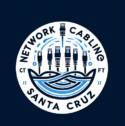Are Ethernet Cables Easy to Install? A Complete Guide for Home and Business Users
If you’ve ever wondered, “Are Ethernet cables easy to install?”, the answer is: it depends. For small home projects, installing Ethernet cables can be fairly straightforward. But when it comes to wiring an entire office, multi-floor building, or structured network system, the process can get complicated fast.
In this guide, we’ll break down what makes Ethernet cabling simple in some cases and challenging in others — plus what you need to know before you start a DIY project or hire a professional installer. Our professional low voltage cabling team in Santa Cruz ensures Ethernet cable installations are done efficiently and safely for both homes and offices.
What Are Ethernet Cables?
Ethernet cables are the physical wires that connect your computers, routers, and other devices to create a wired network. They’re designed to deliver stable, high-speed connections without the interference or lag that sometimes comes with Wi-Fi.
The most common types include:
- CAT5e – Basic, affordable option for everyday internet use
- CAT6 – Supports faster speeds (up to 10 Gbps) and reduced interference
- CAT6a / CAT7 – Ideal for commercial or high-performance networks
Your choice of cable affects both the difficulty of installation and your network’s performance.
Are Ethernet Cables Easy to Install?
If you’re running a few short cables from your router to your computer, yes — Ethernet cables are easy to install. You simply plug one end into your router and the other into your device.
However, if your goal is to wire an entire building, install cables through walls, or create a structured network, things get more technical. Here’s why:
- Routing cables through walls or ceilings requires knowledge of building structure and safety codes.
- Terminating cables with connectors (RJ45) requires precision and the right tools.
- Testing for performance and interference ensures your setup meets data transmission standards.
- Compliance with local regulations is essential, especially in commercial spaces.
So while a short connection is a quick DIY project, a complete Ethernet cabling installation is best handled by a licensed low-voltage professional.
DIY Ethernet Installation: What You’ll Need
If you’re installing cables for your home office or small space, you’ll need:
- Ethernet cable (CAT6 is recommended)
- RJ45 connectors or keystone jacks
- Crimping tool
- Cable tester
- Fish tape or wire puller (for routing through walls)
- Patch panel (optional for larger setups)
Steps for a basic installation:
- Plan your cable routes and measure the total length.
- Cut and strip the cable carefully.
- Match the wire colors according to the T568B standard.
- Crimp or punch down the connectors.
- Test each line for connectivity.
This process works for simple setups, but accuracy matters. Misaligned wires or poor connections can cause performance issues or complete failure.
When to Call a Professional
If your project involves multiple rooms, long cable runs, or business-critical systems, hiring a professional Ethernet installer is the safest and most efficient choice.
Professionals ensure:
- Code compliance – Especially important in California and other regulated states
- Clean, organized wiring – Proper labeling and routing for easy maintenance
- Certified performance – Testing for speed and reliability
- Long-term durability – Proper terminations reduce wear and interference
A professional can also design your structured cabling system, ensuring your network supports future upgrades and higher speeds as technology evolves.
Common Installation Mistakes to Avoid
Whether you’re doing it yourself or managing a project, avoid these common errors:
- Running cables near electrical wiring (causes interference)
- Ignoring cable bend radius or over-tightening ties
- Forgetting to test connections
- Skipping labeling and documentation
- Using cheap, unshielded cables in high-interference environments
These mistakes can cause connection drops, slower speeds, and more expensive fixes later.
Should You Go DIY or Hire an Expert?
Here’s a quick way to decide:
| Project Type | DIY Friendly | Professional Recommended |
|---|---|---|
| Single cable to one device | ✅ Yes | ❌ Not needed |
| Home office (1–2 rooms) | ⚠️ Possible | ✅ If walls involved |
| Whole home wiring | ❌ Complex | ✅ Strongly recommended |
| Office or commercial space | ❌ No | ✅ Required |
| Structured cabling network | ❌ No | ✅ Required |
If you’re unsure, start with a consultation — most cabling companies in California offer free quotes or site evaluations. Before starting the setup, make sure you have the proper tools. Here’s a helpful guide on what tools you need for LAN cables to make the job easier.
Final Thoughts
So, are Ethernet cables easy to install? For quick home connections, yes — it’s a manageable DIY task. But for professional-grade speed, reliability, and compliance, it’s best to work with a certified network cabling installer.
Investing in professional Ethernet installation means faster speeds, cleaner wiring, and fewer headaches in the long run.
If you’re ready to upgrade your home or office network, contact your local Ethernet cabling experts today and get connected the right way.
